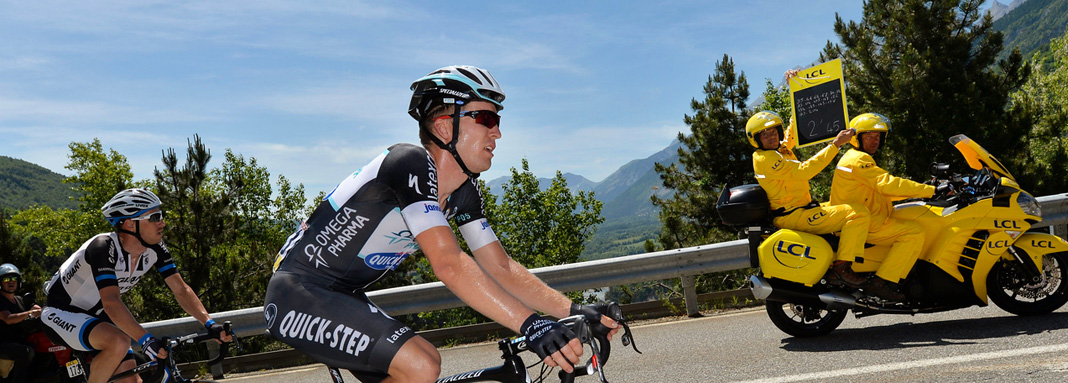At some point on most rides and races you will want to close or create a gap between you and other riders. You might be trying to get across to a breakaway or back to the peloton after a mechanical.
Will you close that gap more easily when climbing, descending or on the flat? Or should you just put your head down and blast it?
Will you close that gap more easily when climbing, descending or on the flat? Or should you just put your head down and blast it?
To figure this out we can take a standard rider in a fixed, crouched position and will calculate how much energy is needed to close a ten second gap in a kilometer (see appendix below regarding the calculation).
Let’s assume he (or she) is pottering along at 150W. We can calculate his speed using a formula and call it v1. By dividing 1000m by v1 we can establish how long it would take him (t1) to cover 1000m with that power output.
We then calculate it again, but use t1 less 10 seconds (t1-10) to figure out the new speed needed, v2 and therefore power required to accomplish that speed.
This is summarized in the table below.
| Slope of road | v1 (m/s) | t1 (s) | v2 (m/s) | Power needed to close the 10 second gap (W) |
|---|---|---|---|---|
| +6% alpine climb | 2.6 | 379 | 2.7 | 154 |
| 0% flat | 8.7 | 114 | 9.6 | 192 |
| -6% downhill | 17.6 | 57 | 21.3 | 772 |
From this table we can see that uphill only 4 more Watts are required (154W compared to 150W) for that 10 second gap to be closed over a kilometer. On the flat we need an extra 42W to close the gap. On downhill we need a whopping 622W extra. A power output of 772W is probably greater than most people could do in a minute, and even if they did, it would be a maximal effort leaving them gasping afterwards.
Closing (or trying to open) gaps on a downhill is therefore usually pointless as so much extra power is required in order to overcome the exponentially greater air resistance and also because there is less time in order to make it up. That’s why the majority of downhill attacks fail. They get swept up as soon as the road turns upwards. Similarly, that's why breakaways with 10 minutes' advantage at the bottom of the last climb usually get caught before the finish.
Also consider that 21.3m/s translates to 76.7kph which is probably beyond the speed at which you can pedal and may not be safe for cornering. That's another reason why it is not practical to make up time on the downhill, since the speed required would be too high.
On the flip side, once you have established a gap on an uphill, it is very difficult for the chasers to close the gap on the downhill. If the finish is on a downhill, then ensure you are at the front early. Nobody's coming past!
Conclusion
If possible, you should try to make up time when going uphill. There is very little point trying to close or create a gap on a descent, especially if the road is straight (requiring no skill).
Of course, if your opponent is cautious about descending in the wet or is already blown, then it may still be reasonable to attack on a downhill. I have seen races won from a downhill attack, but they were probably won in spite of the downhill attack rather than because of it.
Appendix
Calculation of speed from power at pedals requires a reasonably complex formula which needs to know:
Cd Coefficient of drag 0.88
CRR Coefficient of rolling resistance 0.003
FA Frontal Area m2 0.36
G acceleration due to gravity 9.8017m/s2
GR Slope / % +6, 0, -6
M Mass bike and rider/ kg 90
P Power/ W
RHO Air Density kg/m3 1.205
VA Air speed
VG Ground speed m/s
VW Wind speed towards rider m/s
VA = VG + VW
P = G * VG * M * (CR + GR * 0.01) + CD * FA * RHO * 0.5 * (VA ^3)
Links
